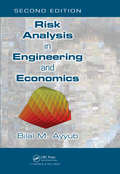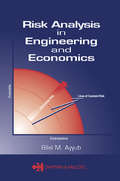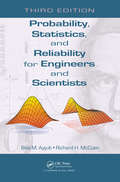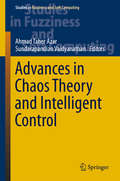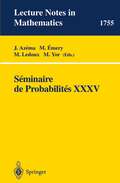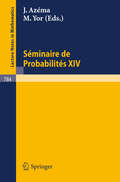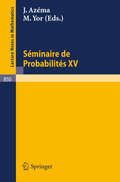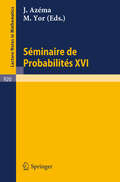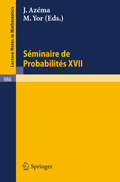- Table View
- List View
Uncertainty Analysis in Engineering and Sciences: Fuzzy Logic, Statistics, and Neural Network Approach (International Series in Intelligent Technologies #11)
by Bilal Ayyub Madan M. GuptaUncertainty has been of concern to engineers, managers and . scientists for many centuries. In management sciences there have existed definitions of uncertainty in a rather narrow sense since the beginning of this century. In engineering and uncertainty has for a long time been considered as in sciences, however, synonymous with random, stochastic, statistic, or probabilistic. Only since the early sixties views on uncertainty have ~ecome more heterogeneous and more tools to model uncertainty than statistics have been proposed by several scientists. The problem of modeling uncertainty adequately has become more important the more complex systems have become, the faster the scientific and engineering world develops, and the more important, but also more difficult, forecasting of future states of systems have become. The first question one should probably ask is whether uncertainty is a phenomenon, a feature of real world systems, a state of mind or a label for a situation in which a human being wants to make statements about phenomena, i. e. , reality, models, and theories, respectively. One cart also ask whether uncertainty is an objective fact or just a subjective impression which is closely related to individual persons. Whether uncertainty is an objective feature of physical real systems seems to be a philosophical question. This shall not be answered in this volume.
Risk Analysis in Engineering and Economics
by Bilal M. AyyubRisk Analysis in Engineering and Economics is required reading for decision making under conditions of uncertainty. The author describes the fundamental concepts, techniques, and applications of the subject in a style tailored to meet the needs of students and practitioners of engineering, science, economics, and finance. Drawing on his extensive e
Risk Analysis in Engineering and Economics
by Bilal M. AyyubMore than any other book available, Risk Analysis in Engineering and Economics introduces the fundamental concepts, techniques, and applications of the subject in a style tailored to meet the needs of students and practitioners of engineering, science, economics, and finance. Drawing on his extensive experience in uncertainty and risk modeling and
Probability, Statistics, and Reliability for Engineers and Scientists
by Bilal M. Ayyub Richard H. McCuenIn a technological society, virtually every engineer and scientist needs to be able to collect, analyze, interpret, and properly use vast arrays of data. This means acquiring a solid foundation in the methods of data analysis and synthesis. Understanding the theoretical aspects is important, but learning to properly apply the theory to real-world p
Probability, Statistics, and Reliability for Engineers and Scientists
by Bilal M. Ayyub Richard H. McCuenIn a technological society, virtually every engineer and scientist needs to be able to collect, analyze, interpret, and properly use vast arrays of data. This means acquiring a solid foundation in the methods of data analysis and synthesis. Understanding the theoretical aspects is important, but learning to properly apply the theory to real-world p
Numerical Analysis for Engineers: Methods and Applications, Second Edition (Textbooks In Mathematics Ser.)
by Bilal Ayyub Richard H. McCuenNumerical Analysis for Engineers: Methods and Applications demonstrates the power of numerical methods in the context of solving complex engineering and scientific problems. The book helps to prepare future engineers and assists practicing engineers in understanding the fundamentals of numerical methods, especially their applications, limitations,
Numerical Analysis for Engineers: Methods and Applications, Second Edition (Textbooks In Mathematics Ser.)
by Bilal Ayyub Richard H. McCuenNumerical Analysis for Engineers: Methods and Applications demonstrates the power of numerical methods in the context of solving complex engineering and scientific problems. The book helps to prepare future engineers and assists practicing engineers in understanding the fundamentals of numerical methods, especially their applications, limitations,
Social Systems Engineering: The Design of Complexity (Wiley Series in Computational and Quantitative Social Science)
by César Garc A-D Az Camilo OlayaUniquely reflects an engineering view to social systems in a wide variety of contexts of application Social Systems Engineering: The Design of Complexity brings together a wide variety of application approaches to social systems from an engineering viewpoint. The book defines a social system as any complex system formed by human beings. Focus is given to the importance of systems intervention design for specific and singular settings, the possibilities of engineering thinking and methods, the use of computational models in particular contexts, and the development of portfolios of solutions. Furthermore, this book considers both technical, human and social perspectives, which are crucial to solving complex problems. Social Systems Engineering: The Design of Complexity provides modelling examples to explore the design aspect of social systems. Various applications are explored in a variety of areas, such as urban systems, health care systems, socio-economic systems, and environmental systems. It covers important topics such as organizational design, modelling and intervention in socio-economic systems, participatory and/or community-based modelling, application of systems engineering tools to social problems, applications of computational behavioral modeling, computational modelling and management of complexity, and more. Highlights an engineering view to social systems (as opposed to a “scientific” view) that stresses the importance of systems intervention design for specific and singular settings Divulges works where the design, re-design, and transformation of social systems constitute the main aim, and where joint considerations of both technical and social perspectives are deemed important in solving social problems Features an array of applied cases that illustrate the application of social systems engineering in different domains Social Systems Engineering: The Design of Complexity is an excellent text for academics and graduate students in engineering and social science—specifically, economists, political scientists, anthropologists, and management scientists with an interest in finding systematic ways to intervene and improve social systems.
Spectral and High Order Methods for Partial Differential Equations - ICOSAHOM 2012: Selected papers from the ICOSAHOM conference, June 25-29, 2012, Gammarth, Tunisia (Lecture Notes in Computational Science and Engineering #95)
by Mejdi Azaïez Henda El Fekih Jan S. HesthavenThe book contains a selection of high quality papers, chosen among the best presentations during the International Conference on Spectral and High-Order Methods (2012), and provides an overview of the depth and breath of the activities within this important research area. The carefully reviewed selection of the papers will provide the reader with a snapshot of state-of-the-art and help initiate new research directions through the extensive bibliography.
Level Sets and Extrema of Random Processes and Fields
by Jean-Marc Azais Mario WscheborA timely and comprehensive treatment of random field theory with applications across diverse areas of study Level Sets and Extrema of Random Processes and Fields discusses how to understand the properties of the level sets of paths as well as how to compute the probability distribution of its extremal values, which are two general classes of problems that arise in the study of random processes and fields and in related applications. This book provides a unified and accessible approach to these two topics and their relationship to classical theory and Gaussian processes and fields, and the most modern research findings are also discussed. The authors begin with an introduction to the basic concepts of stochastic processes, including a modern review of Gaussian fields and their classical inequalities. Subsequent chapters are devoted to Rice formulas, regularity properties, and recent results on the tails of the distribution of the maximum. Finally, applications of random fields to various areas of mathematics are provided, specifically to systems of random equations and condition numbers of random matrices. Throughout the book, applications are illustrated from various areas of study such as statistics, genomics, and oceanography while other results are relevant to econometrics, engineering, and mathematical physics. The presented material is reinforced by end-of-chapter exercises that range in varying degrees of difficulty. Most fundamental topics are addressed in the book, and an extensive, up-to-date bibliography directs readers to existing literature for further study. Level Sets and Extrema of Random Processes and Fields is an excellent book for courses on probability theory, spatial statistics, Gaussian fields, and probabilistic methods in real computation at the upper-undergraduate and graduate levels. It is also a valuable reference for professionals in mathematics and applied fields such as statistics, engineering, econometrics, mathematical physics, and biology.
Statistical Inference for Piecewise-deterministic Markov Processes
by Romain Azaïs Florian BouguetPiecewise-deterministic Markov processes form a class of stochastic models with a sizeable scope of applications: biology, insurance, neuroscience, networks, finance... Such processes are defined by a deterministic motion punctuated by random jumps at random times, and offer simple yet challenging models to study. Nevertheless, the issue of statistical estimation of the parameters ruling the jump mechanism is far from trivial. Responding to new developments in the field as well as to current research interests and needs, Statistical inference for piecewise-deterministic Markov processes offers a detailed and comprehensive survey of state-of-the-art results. It covers a wide range of general processes as well as applied models. The present book also dwells on statistics in the context of Markov chains, since piecewise-deterministic Markov processes are characterized by an embedded Markov chain corresponding to the position of the process right after the jumps.
Statistical Inference for Piecewise-deterministic Markov Processes
by Romain Azais Florian BouguetPiecewise-deterministic Markov processes form a class of stochastic models with a sizeable scope of applications: biology, insurance, neuroscience, networks, finance... Such processes are defined by a deterministic motion punctuated by random jumps at random times, and offer simple yet challenging models to study. Nevertheless, the issue of statistical estimation of the parameters ruling the jump mechanism is far from trivial. Responding to new developments in the field as well as to current research interests and needs, Statistical inference for piecewise-deterministic Markov processes offers a detailed and comprehensive survey of state-of-the-art results. It covers a wide range of general processes as well as applied models. The present book also dwells on statistics in the context of Markov chains, since piecewise-deterministic Markov processes are characterized by an embedded Markov chain corresponding to the position of the process right after the jumps.
Fighting Terrorism at Source: Using Foreign Aid to Delegate Global Security
by Jean-Paul Azam Véronique ThelenThis book offers a unique and insightful econometric evaluation of the policies used to fight transnational terrorism between 1990 and 2014. It uses the tools of modern economics, game theory and structural econometrics to analyze the roles of foreign aid, educational capital, and military intervention. Jean-Paul Azam and Véronique Thelen analyze panel data over 25 years across 124 countries. They prove that foreign aid plays a key role in inducing recipient governments to protect the donors’ political and economic interests within their sphere of influence. Demonstrating that countries endowed with better educational capital export fewer terrorist attacks, they also illustrate that, in contrast, military intervention is counter-productive in abating terrorism. Recognizing the strides taken by the Obama administration to increase the role of foreign aid and reduce the use of military interventions, this book shows the significant impact this has had in reducing the number of transnational terrorist attacks per source country, and suggests further developments in this vein. Practical and timely, this book will be of particular interest to students and scholars of economics and political science, as well as those working on the wider issue of terrorism. Presenting a series of new findings, the book will also appeal to international policy makers and government officials.
Differential Equations and Dynamical Systems: 2 Usuzcamp, Urgench, Uzbekistan, August 8-12 2017 (Springer Proceedings in Mathematics & Statistics #268)
by Abdulla Azamov Leonid Bunimovich Akhtam Dzhalilov Hong-Kun ZhangThis book features papers presented during a special session on dynamical systems, mathematical physics, and partial differential equations. Research articles are devoted to broad complex systems and models such as qualitative theory of dynamical systems, theory of games, circle diffeomorphisms, piecewise smooth circle maps, nonlinear parabolic systems, quadtratic dynamical systems, billiards, and intermittent maps. Focusing on a variety of topics from dynamical properties to stochastic properties of dynamical systems, this volume includes discussion on discrete-numerical tracking, conjugation between two critical circle maps, invariance principles, and the central limit theorem. Applications to game theory and networks are also included. Graduate students and researchers interested in complex systems, differential equations, dynamical systems, functional analysis, and mathematical physics will find this book useful for their studies. The special session was part of the second USA-Uzbekistan Conference on Analysis and Mathematical Physics held on August 8-12, 2017 at Urgench State University (Uzbekistan). The conference encouraged communication and future collaboration among U.S. mathematicians and their counterparts in Uzbekistan and other countries. Main themes included algebra and functional analysis, dynamical systems, mathematical physics and partial differential equations, probability theory and mathematical statistics, and pluripotential theory. A number of significant, recently established results were disseminated at the conference’s scheduled plenary talks, while invited talks presented a broad spectrum of findings in several sessions. Based on a different session from the conference, Algebra, Complex Analysis, and Pluripotential Theory is also published in the Springer Proceedings in Mathematics & Statistics Series.
Advances in Chaos Theory and Intelligent Control (Studies in Fuzziness and Soft Computing #337)
by Ahmad Taher Azar Sundarapandian VaidyanathanThe book reports on the latest advances in and applications of chaos theory and intelligent control. Written by eminent scientists and active researchers and using a clear, matter-of-fact style, it covers advanced theories, methods, and applications in a variety of research areas, and explains key concepts in modeling, analysis, and control of chaotic and hyperchaotic systems. Topics include fractional chaotic systems, chaos control, chaos synchronization, memristors, jerk circuits, chaotic systems with hidden attractors, mechanical and biological chaos, and circuit realization of chaotic systems. The book further covers fuzzy logic controllers, evolutionary algorithms, swarm intelligence, and petri nets among other topics. Not only does it provide the readers with chaos fundamentals and intelligent control-based algorithms; it also discusses key applications of chaos as well as multidisciplinary solutions developed via intelligent control. The book is a timely and comprehensive reference guide for graduate students, researchers, and practitioners in the areas of chaos theory and intelligent control.
Growth Theory of Subharmonic Functions (Birkhäuser Advanced Texts Basler Lehrbücher)
by Vladimir S. AzarinIn this book an account of the growth theory of subharmonic functions is given, which is directed towards its applications to entire functions of one and several complex variables. The presentation aims at converting the noble art of constructing an entire function with prescribed asymptotic behaviour to a handicraft. For this one should only construct the limit set that describes the asymptotic behaviour of the entire function. All necessary material is developed within the book, hence it will be most useful as a reference book for the construction of entire functions.
Stochastic Optimization in Insurance: A Dynamic Programming Approach (SpringerBriefs in Quantitative Finance)
by Pablo Azcue Nora MulerThe main purpose of the book is to show how a viscosity approach can be used to tackle control problems in insurance. The problems covered are the maximization of survival probability as well as the maximization of dividends in the classical collective risk model. The authors consider the possibility of controlling the risk process by reinsurance as well as by investments. They show that optimal value functions are characterized as either the unique or the smallest viscosity solution of the associated Hamilton-Jacobi-Bellman equation; they also study the structure of the optimal strategies and show how to find them.The viscosity approach was widely used in control problems related to mathematical finance but until quite recently it was not used to solve control problems related to actuarial mathematical science. This book is designed to familiarize the reader on how to use this approach. The intended audience is graduate students as well as researchers in this area.
Shape Optimization Problems (Springer Optimization and Its Applications #164)
by Hideyuki AzegamiThis book provides theories on non-parametric shape optimization problems, systematically keeping in mind readers with an engineering background. Non-parametric shape optimization problems are defined as problems of finding the shapes of domains in which boundary value problems of partial differential equations are defined. In these problems, optimum shapes are obtained from an arbitrary form without any geometrical parameters previously assigned. In particular, problems in which the optimum shape is sought by making a hole in domain are called topology optimization problems. Moreover, a problem in which the optimum shape is obtained based on domain variation is referred to as a shape optimization problem of domain variation type, or a shape optimization problem in a limited sense. Software has been developed to solve these problems, and it is being used to seek practical optimum shapes. However, there are no books explaining such theories beginning with their foundations.The structure of the book is shown in the Preface. The theorems are built up using mathematical results. Therefore, a mathematical style is introduced, consisting of definitions and theorems to summarize the key points. This method of expression is advanced as provable facts are clearly shown. If something to be investigated is contained in the framework of mathematics, setting up a theory using theorems prepared by great mathematicians is thought to be an extremely effective approach. However, mathematics attempts to heighten the level of abstraction in order to understand many things in a unified fashion. This characteristic may baffle readers with an engineering background. Hence in this book, an attempt has been made to provide explanations in engineering terms, with examples from mechanics, after accurately denoting the provable facts using definitions and theorems.
Seminaire de Probabilites XXXIII (Lecture Notes in Mathematics #1709)
by J. Azema M. Emery M. Ledoux M. YorSeminaire de Probabilites XXXIV (Lecture Notes in Mathematics #1729)
by J. Azema M. Emery M. Ledoux M. YorThis volume contains 19 contributions to various subjects in the theory of (commutative and non-commutative) stochastic processes. It also provides a 145-page graduate course on branching and interacting particle systems, with applications to non-linear filtering, by P. del Moral and L. Miclo.

